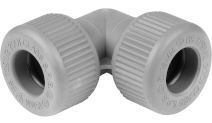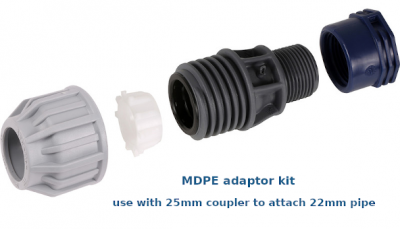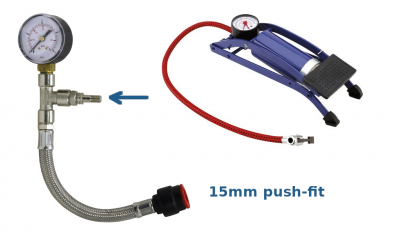Finding water leaks
Posted by: @editorOne weird thing is that there isn’t a consistent water loss
Perhaps the leak after a float valve and flow therefore intermittent? Do you have an vented hot water system or some other system with level controlled via a float valve?
@ronin92, we have a vented hot water cylinder, but no clue if there are any level controlling float valves.
Just to give you an idea, we watched TV tonight with no water usage (washing machine, dishwasher, etc.). First 40 minute segment, we registered 11 litres used. Went back to watch TV. Next 40 minute chunk was 48 litres - more than one litre per minute. Scary. I’ll take a reading tonight when we go to bed and see what it registers in the morning.
Get a copy of The Ultimate Guide to Heat Pumps
Subscribe and follow our YouTube channel!
Posted by: @editor@ronin92, we have a vented hot water cylinder, but no clue if there are any level controlling float valves.
Just to give you an idea, we watched TV tonight with no water usage (washing machine, dishwasher, etc.). First 40 minute segment, we registered 11 litres used. Went back to watch TV. Next 40 minute chunk was 48 litres - more than one litre per minute. Scary. I’ll take a reading tonight when we go to bed and see what it registers in the morning.
If you have a vented hot water cylinder, then you will probably have a supply tank in the loft, which will have a ball cock valve supplied from your water main. There will also be an overflow pipe connected to the tank in case the ball cock valve does not fully seat.
@derek-m That's worth noting. If that valve is intermittently failing to seat and the overflow connects into the gutter downpipe or somewhere concealed, you'll never see the overflow. Mine pours off just outside the eaves and would be obvious.
@derek-m, I don’t know what’s wrong with me at the moment. Our tank is unvented.
Get a copy of The Ultimate Guide to Heat Pumps
Subscribe and follow our YouTube channel!
Really silly question, @editor, but have you checked all the overflow pipes from your various toilets? And, of course, the toilets themselves? Just thinking of badly operating dual-flush systems and degraded cistern washers, either of which could introduce significant wastage.
I know you're almost certain to say yes but I thought it best to check nonetheless.....
105 m2 bungalow in South East England
Mitsubishi Ecodan 8.5 kW air source heat pump
18 x 360W solar panels
1 x 6 kW GroWatt battery and SPH5000 inverter
1 x Myenergi Zappi
1 x VW ID3
Raised beds for home-grown veg and chickens for eggs
"Semper in excretia; sumus solum profundum variat"
Or perhaps water softener not working as it should if you habe one installed. Did you have any joy speaking with your insurance company. Friends of ours had a leaking UFH which only came light after the side walls in their kitchen started to show signs of damp. They had the work covered under their insurance and got the issue resolved and pretty much a new kitchen and tiles. Hopefully your issue isn't this but would certainly recommend getting a specialist in for leak detection. They should have all the equipment to find it.
binge watching might solve the issue without even looking
https://www.youtube.com/shorts/_Tz94Hu6hMQ
@dandee, sadly not. We've narrowed down to where the leak may be, and we've asked our plumber to come around and have a look – that was three weeks ago. Hopefully they'll have time for us soon.
Get a copy of The Ultimate Guide to Heat Pumps
Subscribe and follow our YouTube channel!
Apologies @editor - I've only just come across this plea for help.
I have extensive experience of water supply issues because we have our own well.
OK, we don't have a mains supply. But leaks are still a problem because it costs electricity to run the pump.
Posted by: @editorJust to give you an idea, we watched TV tonight with no water usage (washing machine, dishwasher, etc.). First 40 minute segment, we registered 11 litres used. Went back to watch TV. Next 40 minute chunk was 48 litres - more than one litre per minute. Scary.
The speed of water leakage is proportional to the pressure in the pipe.
When water is being drawn off within the house, then the pressure drops in the supply pipe and less water leaks.
In my house it's actually quite tricky to be certain that there's no water usage.
With two header tanks (one treated and one un-treated) plus four(!) toilets, there can be several things happening across the different floor levels which I have to check.
Solutions:
1: Water Supply engineers use a 2m-long pole to listen for leaks.
You place one end on a pipe and put the other end to your ear.
The closer you are to the leak, the greater the volume and the more "detail" you can hear in the sound form.
2: It's usually quicker (and much cheaper) to run a completely new pipe, rather than try to excavate and 'find' the leak.
Most of the work is excavation, lifting flooring etc.
You need no 'plumbing skills' to prepare a route for the new pipe!
2a: An underground supply pipe to a property is usually blue MDPE at 25mm diameter. Cost is about £1 per metre.
Fittings are chunky screw-type with O-rings. Agricultural supply outlets usually stock loads at reasonable prices.
2b: Internal pipes are commonly grey Polybutylene.
You can buy coils of it between 10-50m long at about £2.50/m for 22mm diam, and £1.50/m for 15mm diam.
Once again, quick-connect fittings are plentiful.
They are usually modeled on the Hep2O design with an O-ring and a sharks-tooth stainless-steel ring, which grips the pipe.
To make a connection, you push in the pipe. To remove one, you unscrew the hand-tight outer-casing at that end.
All ranges of quick-fit plastic connectors have the ability to connect directly between plastic and copper,
or else you buy an 'adapter' which is inserted to reduce the diameter at that end of the fitting.
3: Whenever I have a section of water-pipe 'open' I take the opportunity to add an isolation valve.
That enables me flexibility to trace faults and test for leaks in sections.
4: I have a pressure-test 'kit'.
This comprises a gauge on a flex-hose to which I can connect a foot-pump.
The other end attaches to a water pipe which I pressurise to about 2-bar.
If it remains static over 5mins, then I'm confident that the pipe isn't leaking.
I have a number of push-fit adaptors which I can use to check pipes of different sizes.
Although this is usually called a 'dry pressure test' device, in practice it works even if the pipework still contains water.
It's actually quicker to do a pressure test on a pipe section with water in it, because only the air is compressible when using the foot-pump.
Save energy... recycle electrons!
- 26 Forums
- 2,378 Topics
- 53.9 K Posts
- 275 Online
- 6,060 Members
Join Us!
Worth Watching
Latest Posts
-
RE: Radiator sizing sanity check
@jamespa Thanks, yes. it’s even more difficult as on...
By Papahuhu , 48 seconds ago
-
A sneak preview of the onboard compensation curve desig...
By F1p , 6 minutes ago
-

RE: Solar Power Output – Let’s Compare Generation Figures
@papahuhu They came to ‘axe you’ what you were up to?
By Toodles , 24 minutes ago
-
RE: Cascade 2x Grant Areona 10kw ASHP - Ongoing setup issues
Either complete Bow Locks or at best a marginal effect....
By JamesPa , 1 hour ago
-

RE: Testing new controls/monitoring for Midea Clone ASHP
I had a look and it looks complicated to me! There may ...
By cathodeRay , 1 hour ago
-
Hi all I’m looking to get some insight on what others...
By Renewables345 , 1 hour ago
-

RE: The Great British Heat Pump Owner Persona Survey: Let's Build Our Archetype!
@mosibi, go on then, complete the survey. Let's get the...
By Mars , 2 hours ago
-
RE: Water Hammer After Heat Pump Install
@jaynieq I wish you luck with this one. I think the ma...
By JamesPa , 4 hours ago
-
RE: Grant ASHP 17.5 kw. weather curve
All sounds good and like you know what you are doing. R...
By JamesPa , 4 hours ago
-
RE: Optimum new build house design for Heat Pump
From first principles I would say: Definitel...
By JamesPa , 19 hours ago
-

RE: Weather compensation- why you should use it
As good a place as any to drop this video:/p>
By Mars , 22 hours ago
-
RE: Forum updates, announcements & issues
@transparent D'Oh - I did look before I posted but I mi...
By dr_dongle , 24 hours ago
-
Compatibility with Samsung AE080RXYDEH
I am new to all this. We have a SamsungAE080RXYDEH that...
By John999 , 24 hours ago
-
RE: New Fogstar 15.5kWh upright solution
@batpred Maybe you should buy your additional batter...
By Bash , 1 day ago
-

RE: Data Accuracy Problem: Daikin 8kW Heat Pump's Onecta App vs MMI Power Consumption
@nursethescreens Yes, comfort and happiness of the fami...
By Toodles , 1 day ago
-
RE: Connecting Growatt SPH5000 over wired ethernet rather than wireless
Thanks folks. I had tried googling an ethernet lab adap...
By z8lccda , 2 days ago
-
RE: Changing from 4-port buffer to volumizer
@toodles I'm not concerned that the behaviour is not no...
By Andy1618 , 2 days ago
-

-

RE: Setback savings - fact or fiction?
I agree, and I think there are two things in play here....
By cathodeRay , 2 days ago
-
RE: Help needed with Grant Aerona 3 issues
First time posting so bear with me. Some bits that have...
By Adamp , 3 days ago









